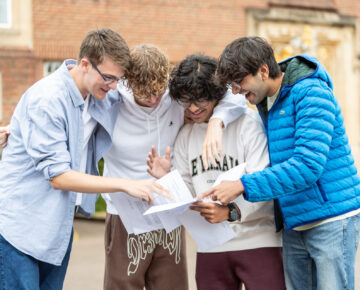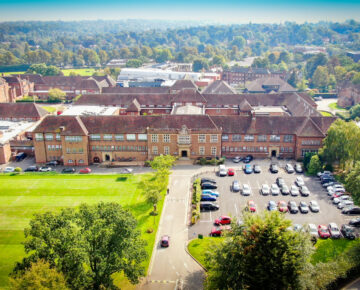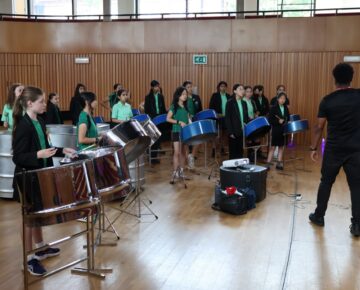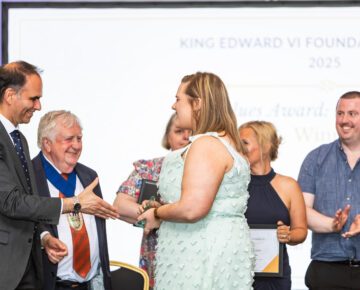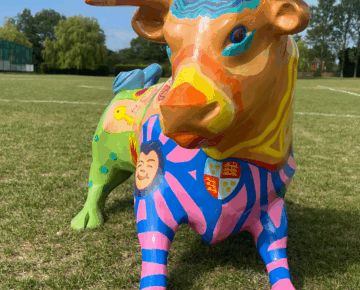Lord Mayor Wiggins-Davies and the Birmingham Victory Day Celebrations
In the Board Room of the Schools of King Edward VI in Birmingham hangs an imposing portrait of a long-forgotten Foundation Governor.
So who is this aged, rather portly praetorian guard, standing sentinel over Board meetings?
A cursory delve into the archives unmasks him as Alderman William Theophilus Wiggins-Davies (1887-1960), the son of a railway worker, who became a successful local businessman manufacturing stationery. With a great interest in politics, he served the City as a Councillor, Justice of the Peace and Lord Mayor (1944-1945).
[caption id="attachment_8469" align="aligncenter" width="327"] Councillor WT Wiggin-Davies, the new Lord Mayor with his daughter, Joan.[/caption]
Councillor WT Wiggin-Davies, the new Lord Mayor with his daughter, Joan.[/caption]
During his term of office Lord Mayor Wiggins-Davies was a key figure in the 1945 Victory Day celebrations in Victoria Square, which according to newspaper reports got off to a shaky start. The Birmingham Daily Gazette, 9th May, 1945, recounts his desperate attempts to “retrieve a blunder”:
“The tragedy of V-Day in Birmingham was that Victoria Square had not been equipped with loud-speakers. Just before three o’clock the Square was choc-a-bloc with thousands of people evidently expecting to hear a relay of the Premiere’s [Churchill’s] speech.”
Wiggins-Davies valiantly came to the rescue by propping open the window to the Lord Mayor’s Parlour with a stool and placing his own wireless on the ledge in the hope that some of the crowd would hear the address. Few did, and in an attempt to raise spirits Wiggins-Davies led the crowd in community singing before heading off on a tour of the suburbs where he saw amongst other things “an effigy of Hitler hanging on an lamp post in Blythe Street, Ladywood!”
Birmingham children celebrated in their thousands and many dressed up in outfits of red, white and blue. The street parties “had to be seen to be believed” and the lucky children of Kingston Road, Small Heath “enjoyed one of the best efforts of the city”.
[caption id="attachment_8472" align="aligncenter" width="257"] Birmingham Daily Gazette, 9th May, 1945[/caption] [caption id="attachment_8473" align="aligncenter" width="264"]
Birmingham Daily Gazette, 9th May, 1945[/caption] [caption id="attachment_8473" align="aligncenter" width="264"] The Lord Mayor celebrates with children “anxious to be in the picture”[/caption]
The Lord Mayor celebrates with children “anxious to be in the picture”[/caption]
Sunday 13th May witnessed a huge Victory Parade with more than 18,000 Service men and women and workers taking part in a procession nearly four miles long. Joining the parade was a battalion of nearly 700 African-American women of the US Women’s Army Corps, based at King Edward’s School to manage the postal service for the US Army in Europe.
[caption id="attachment_8474" align="aligncenter" width="476"] The Birmingham Mail, 14th May, 1945[/caption]
The Birmingham Mail, 14th May, 1945[/caption]
Despite the initial blunder, the City’s V-Day celebrations went well and the Lord Mayor was pleased with how Brummies had conducted themselves:
[caption id="attachment_8475" align="aligncenter" width="518"] Evening Despatch, 10th May, 1945[/caption]
Evening Despatch, 10th May, 1945[/caption]
The Birmingham Gazette also reflected on how memorable the celebrations had been, adding that the Lord Mayor’s calls for “sober enthusiasm” had perhaps not been heeded by all:
[caption id="attachment_8476" align="aligncenter" width="391"] The Birmingham Gazette, 11th May, 1945[/caption]
The Birmingham Gazette, 11th May, 1945[/caption]
In the same article, we are told that the statue of King Edward VII was found the following morning wearing a red fez, Queen Victoria looked out on the square from under a trilby hat and Sir Josiah Mason over in Chamberlain Square sported a dustbin lid on his head. It would appear that Birmingham’s V-Day celebrations may have been a little less soberly than Lord Mayor Wiggins-Davies had hoped for!



